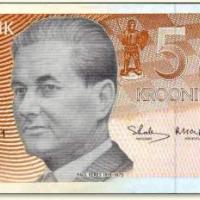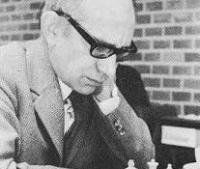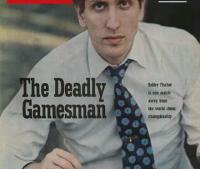
The Crown Prince of Chess
Paul Petrovich Keres was born on January 7, 1916, in Narva, Estonia. Keres first learned about chess from his father and older brother Harald.
In 1935, Keres became the chess champion of Estonia, defeating Gunnar Friedemann for the title. Keres began earning acclaim by playing on the top board for Estonia in the 6th Chess Olympiad at Warsaw.
In 1938 he tied with Fine for first, with 8.5/14, in the all-star AVRO tournament, held in various cities in the Netherlands, ahead of chess legends Mikhail Botvinnik, Max Euwe, Reshevsky, Alekhine, Capablanca, and Flohr. AVRO was one of the strongest tournaments in history; some chess historians believe it was the strongest ever staged. Keres won on tiebreak because he beat Fine 1½–½ in their individual two games.

It was expected that the winner of this tournament would be the challenger for the World Champion title, in a match against World Champion Alexander Alekhine, but the outbreak of the Second World War, especially the first occupation of Estonia by the Soviet Union in 1940–1941, brought negotiations with Alekhine to an end. Keres had begun his university studies in 1937, and this also played a role in the failed match.
Keres found himself harassed by Soviet authorities on multiple occasions, most notably during the 1948 World Championship tournament, where Soviet chess officials threatened him to throw matches to allow Botvinnik to take the title of world champion. Keres chose to play fairly, but still did not manage to win the title.
He won the strong USSR Chess Championship three times (1947, 1950 and 1951).
Keres made many important contributions to opening theory. Perhaps best-known is the Keres Attack against the Scheveningen Variation of the Sicilian Defense (1.e4 c5 2.Nf3 d6 3.d4 cxd4 4.Nxd4 Nf6 5.Nc3 e6 6.g4), which was successfully introduced against Efim Bogoljubov at Salzburg 1943, and today remains a topical and important line. An original system on the Black side of the Closed Ruy Lopez (1.e4 e5 2.Nf3 Nc6 3.Bb5 a6 4.Ba4 Nf6 5.0-0 Be7 6.Re1 b5 7.Bb3 d6 8.c3 0-0 9.h3 Na5 10.Bc2 c5 11.d4 Nd7) was introduced by Keres at the 1962 Candidates' tournament, and it had a run of popularity for several years. He also popularized the Keres Defense (1.d4 e6 2.c4 Bb4+). Another important system on the Black side of the English Opening was worked out by him; it runs 1.c4 e5 2.Nc3 Nf6 3.g3 c6.
His rival Samuel Reshevsky, while paying tribute to Keres' talent, tried to pinpoint why Keres never became world champion, and also complimented his friendly personality. "Well, I believe that Keres failed in this respect because he lacked the killer instinct. He was too mild a person to give his all in order to defeat his opponents. He took everything, including his chess, philosophically. Keres is one of the nicest people that I have ever had the pleasure of meeting. With his friendly and sincere smile, he makes friends easily. He is good-natured and kind. Yes, he loves chess, but being a human being is his first consideration. In addition to chess, Keres was interested in tennis, Ping-Pong, swimming, and bridge."
He was ranked among the top 10 players in the world for close to 30 years, between approximately 1936 and 1965, and overall he had one of the highest winning percentages of all grandmasters in history.
Many chess historians consider Keres the strongest player never to become World Chess Champion. He was nicknamed "The Crown Prince of Chess." Keres was the only player in chess history to defeat nine undisputed world champions.
He died of a heart attack on June 5, 1975 in Helsinki, Finland at the age of 59. The five kroon’s (5 krooni) Estonian banknote bears his portrait. A statue honoring him can be found on Tõnismägi in Tallinn. An annual international chess tournament has been held in Tallinn every year since 1969. Keres won this tournament in 1971 and 1975. Starting in 1976 after Keres' death, it has been called the Paul Keres Memorial. There are also a number of chess clubs and festivals named after him. In 2000, he was elected the Estonian Sportsman of the Century.






